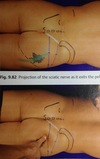Pelvic region Flashcards
(61 cards)
Sacrotuberous ligament - one of the strongest collagenous structures in the ms system (diagram)
wide as the thumb, found on palpation with px prone, between ischial tuberosity and inferolateral angle of sacrum

Diagram showing how long head of the biceps femoris blends with the sacrotuberous ligament
Action of Biceps femoris : flex the knee joint and laterally rotate

Impingement Test
Test to assess integrity of the acetabular labrum.
Patient is supine.
Practitioner initiates internal rotation.
Practitioner then passively flexes symptomatic hip to 90 degrees and adducts
Reproduction of symptoms in mid superior thigh inferior to the inguinal ligament indicates suspected labral tear or FAI
Symptoms may include pain and an audible click or just pain.
projection of the piriformis muscles (diagram)
a rounded structure that is firmer that its direct surroundings

what happens when the arms are elevated whilst px is lying prone?
it tenses the thoracolumbar fascia and impedes palpate of lumbosacral structures
Fitzgerald Test - Posterior Labrum
Test to assess integrity of the acetabular labrum
Patient supine
Practitioner passively fully flexes, adducts and internally rotates patient’s hip.
Practitioner then extends the hip whilst abducting and externally rotating in one continual movement.
Pain with or without an audible click is considered a positive test.
FABER Test:
General screening test for hip joint pathology.
Patient supine, practitioner instructs patient to cross symptomatic leg so that the ipsilateral ankle rests
above the contralateral knee.
Practitioner then stabilizes the contralateral ASIS and supports the ipsilateral knee until end of range
Practitioner then applies gentle downward pressure to the medial aspect of the patients knee
Reproduction of pain or inability to perform test due to pain is considered a positive test.
FABER (Patrick) test
- for hip joint pain
Flexion, abduction & external rotation of the hip joint passively with your patient supine.
This test can be used for the pelvis as part of a test cluster to differentiate hip joint pain from SIj pain.
It is assumed once the hip joint is at end of range this test will stress the anterior ligaments of the SIJ and the pubic symphysis
o Location of pain is an important factor in determining origin.
MET - improve external rotation of hip joint
Piriformis MET – Px. Prone
Knee flexed,
px. Resists movement towards the midline.
Practitioner holds piriformis muscle.
Exhale and move leg outwards.
What are the pelvic ligaments? (5)
interosseous sacroiliac ligaments
anterior sacroiliac ligaments
posterior sacroiliac ligaments
sacrotuberous ligaments
sacrospinous ligaments
Which nerve gets affected in the dysfunctional abductor muscle of Trendelenburg gait?
Superior Gluteal nerve
position of nerves in the gluteal region (diagram)

Diagram showing the superolateral border of the gluteus maximus (approx)

Femoroacetabular impingement image - Cam
What type of joint is the SI joint?
Arthroidal.
Hyaline cartilage on the sacral side, fibro-cartilage on the ilial side.
sciatica nerve exiting piriformis (diagram)
further down the sciatic nerve can be palpated laterally, between the ischial tuberosity and the superior aspect of g.t. (as line is drawn). It runs directly lateral to tuberosity.

Seated Flexion Test
ROM test

Both thumbs on inferior slope of each posterior superior iliac spine.
Patient bends forwards with arms between the knees, as far as possible.
The PSIS that moves furthest in a superior or anterior is +ve, indicative of restricted mobility on that side.
Observe lumbar and thoracic vertebrae.
This test takes out lower extremities as an influencing factor.
If iliac crest is unlevel when seated initially then innominates are unequal size.
Trendelenburg test
Test for weakness/atrophy of hip abductor muscles. (often occurs with a hip pathology)
Patient standing with feet hip width apart.
Practitioner instructs patient to stand on one leg and observes levels of iliac crests
Test is considered positive if the iliac crest is high on the stance leg and lower on the lifted leg
May indicate underlying hip joint pathology and weakness of gluteus medius
How can you palpate the G.T. in obese patients?
in prone position, flex the knee and rotate laterally and medially to move the G.T.
what structure might you find when palpating superiorly to the ischial tuberosity?
insertion of the sacrotuberous ligament
What tends to be affected in a degenerative hip joint?
Medial rotation
If long posterior sacroiliac joint is painful inferior to PSIS, what does this indicate?
SI joint pathology
where are the PSIS in relation to the lumbar dimples?
approx 2cm lateral and 2cm inferior
POSH (posterior shear) test
for the Sacro-iliac Joint
Patient supine
Practitioner passively flexes thigh at the hip and optionally places hand at the superior pole of the SIJ to palpate ROM, quality of movement and tissue texture.
Practitioner supports thigh at the knee with a broad secure contact using arm and axilla
Practitioner exerts a gradual even posterior compressive force into the SIJ taking care to note any signs of hip joint pain
Reproduction of SIJ symptoms is a positive test.










